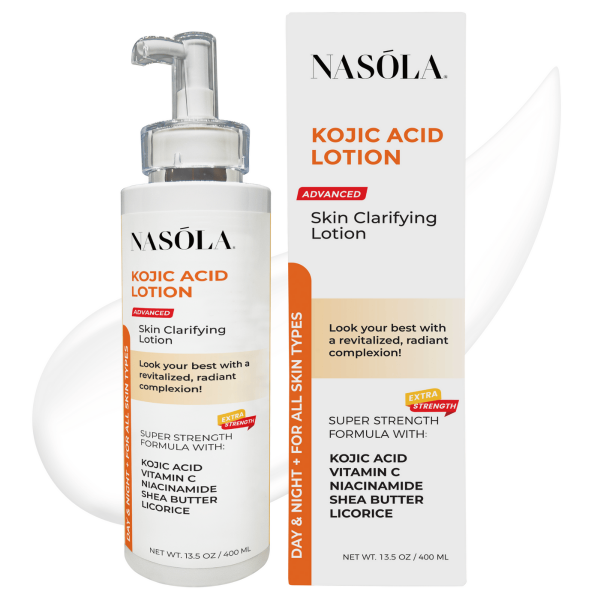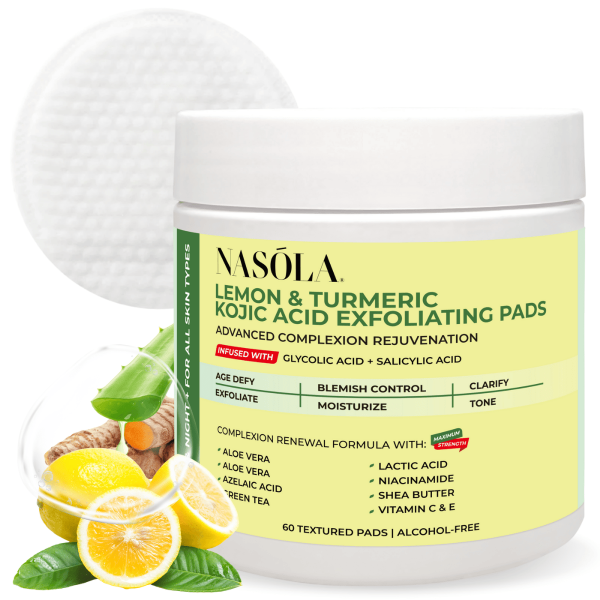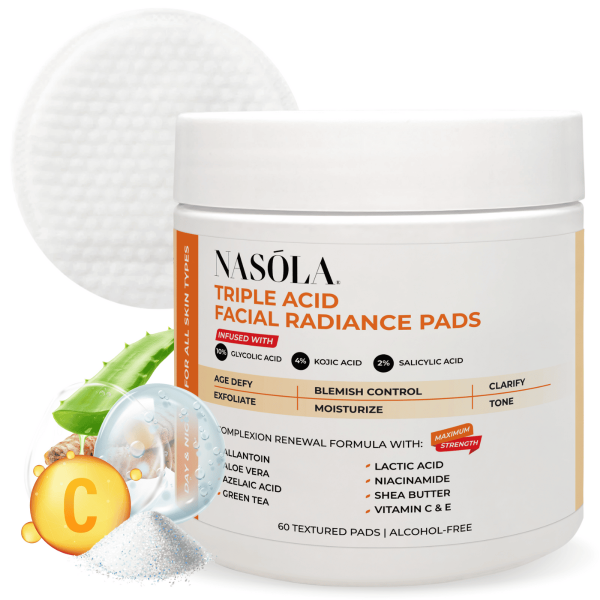Uneven skin tone, post-acne marks, stubborn sunspots—sound familiar? If you’ve ever stared at yourself in the mirror and thought, “How long does kojic acid take to fade hyperpigmentation?”… you’re in good company.
Kojic acid has been steadily rising to star status in skincare routines—especially among those of us searching for brighter days (and brighter skin).
This naturally derived active works by tamping down the production of melanin (that’s the pigment behind those dark marks you’re trying to get rid of).
With consistent use and the right combo of products, kojic acid can absolutely shift the tone (pun intended) of your skin.
Stick around—I’ll walk you through not only how long it usually takes but also how to speed things along using treatments like the Nasola Kojic Acid Lotion, Nasola Kojic Acid Cream, and glow-getting essentials like the Nasola Triple Acid Facial Radiance Pads.
- How Long Does Kojic Acid Take to Fade Hyperpigmentation?
- Best Kojic Acid Creams for Targeted Hyperpigmentation
- How to Use Kojic Acid in Your Skincare Routine
- Enhancing Results with the Right Kojic Acid Exfoliator
- Lifestyle Tweaks That Improve Kojic Acid Results
- Ingredient Showdown: Kojic Acid vs. Other Brighteners
- Conclusion
- Frequently Asked Questions
How Long Does Kojic Acid Take to Fade Hyperpigmentation?
Knowing how kojic acid works makes its timeline much easier to appreciate. This active ingredient isn’t some one-night miracle—it’s powerful, yes—but it needs time, commitment, and backup dancers (aka your skincare routine!).
When used correctly, kojic acid decreases the amount of melanin your skin produces by targeting the tyrosinase enzyme. Bonus: It’s derived from fungi and is 100% vegan-friendly.
Generally, most users can expect to notice:
- Brightening of mild hyperpigmentation in 2–4 weeks.
- Fading of deeper acne scars or melasma in 8–12 weeks.
- Even more dramatic improvements with exfoliation and sun protection.
- Slower results when not combined with complementary ingredients.
So what does that really mean?
This isn’t just “apply-and-forget.” You’ll want to stay consistent, avoid skipping your sunscreen, and pair treatments wisely.
For example, using the Nasola Kojic Acid Lotion all over your body daily can tremendously help with discoloration on the arms, chest, and legs.
Understanding Kojic Acid on Melanin Production
Kojic acid is celebrated for its ability to interfere with the production of melanin in the skin—melanin being the stuff responsible for hundreds of skin tone variations across the world.
But excess pigmentation, especially from sun exposure or post-inflammatory responses, can become problematic.
Here’s where kojic acid shines.
It targets tyrosinase. That’s the enzyme that helps produce melanin. By blocking tyrosinase, kojic acid puts a damper on melanin production, helping fade things like:
- Post-acne marks
- Age spots
- Uneven skin tone
- Melasma
Mix it with medical-grade products and boom—the transformation is real.
Why Results Differ for Everyone
Not everyone will clock glowing results at the same rate. Our skin types, exposure to sunlight, daily habits, and even stress levels can affect how quickly our dark spots fade.
What accelerates results for one may stall them for another.
Those with oily or combination skin typically respond faster—think 4–6 weeks. Dry or sensitive skin types might experience a slower (though still effective) journey to brightness.
Also, darker skin tones may need more time to notice change, but the results will come.
Best Kojic Acid Creams for Targeted Hyperpigmentation

There’s a reason creams exist in our skincare world—especially for stubborn spots. When it comes to focused treatment, you’ll want options that deliver pigment-correcting ingredients right where it counts. Let’s talk about what’s truly worth it.
The best kojic acid creams pair lightening power—like kojic acid—with barrier supporters like niacinamide for effectiveness and skin wellness.
- Formulated for spot treating hardened discoloration
- Ideal for acne scars, freckles, and melasma
- Work well overnight when the skin is in regeneration mode
- Strengthen skin over time, reducing the chance of recurrence
One of my favorite go-to’s?
The Nasola Kojic Acid Cream. It blends kojic acid with niacinamide (a hydration king) and collagen, which smooths and heals—perfect for nighttime brightening.
Spot Treating Stubborn Scars at Home
When you’re dealing with one or two dark marks that just won’t budge, focusing your treatment is key. Broadly applying ingredients might not do the trick quickly enough.
That’s why applying a targeted formula like Nasola Kojic Acid Cream to individual areas speeds up recovery. Why?
Because the product is concentrated right where melanin is pooling.
Plus, niacinamide supports skin balance and reduces inflammation. And collagen? That helps reinforce cell turnover—faster healing, stronger results.
Use it nightly for:
- Old acne scars
- Freckles from sun damage
- Melasma patches
- Scars on the cheeks or upper lip
Niacinamide Makes Kojic Acid Better
Kojic acid is a superstar—but add niacinamide and suddenly we’re Grammy-level. Niacinamide complements kojic acid by offering a serious anti-inflammatory effect. That means less redness and fewer breakouts while you fade your spots.
Consistent use of Nasola Kojic Acid Cream lets you:
- Improve skin tone
- Minimize pore size
- Boost hydration levels
- Improve your skin’s resilience
End result? Stronger, healthier skin that looks luminous.
How to Use Kojic Acid in Your Skincare Routine
Layering skincare products may feel like assembling IKEA furniture without instructions—but when done right, it’s magical. Using kojic acid with complementary ingredients maximizes its clearing powers and ensures your skin stays happy.
The key? Don’t overwhelm your skin. Use active ingredients wisely, and allow skin time to adjust.
- Cleanse first to start with a clean base
- Apply kojic acid second for direct absorption
- Layer niacinamide (or other serums) after
- End with SPF (always!) in the morning routine
In short: think balance, not overload.
Smart Product Layering for Bright Results
Mixing kojic acid with AHAs like glycolic or lactic acid can really kickstart fading. But don’t slather everything at once.
Start with exfoliation no more than 2–3 times per week. Then layer your kojic acid cream or lotion. For days when you need an exfoliating boost? Say hello to Nasola Triple Acid Facial Radiance Pads.
Why they’re brilliant:
- Contain glycolic, salicylic, and lactic acid
- Sweep away dead skin cells
- Make way for kojic acid to penetrate deeper
- Improve skin texture visibly after just a few uses
Morning vs Evening Kojic Acid Routines
Use kojic acid creams at night and lightweight lotions in the morning. Why?
Because your skin heals while you sleep—and lotion absorbs better with your daily SPF.
For full-face or body fading, apply Nasola Kojic Acid Lotion in the morning before sunscreen. Use Nasola Kojic Acid Cream at night to hit those stubborn areas hard.
This rhythm lets your skin adjust and avoid sensitivity.
Enhancing Results with the Right Kojic Acid Exfoliator

Sometimes fading hyperpigmentation needs a little push—think of exfoliation as the motivational coach on the sidelines. Dead skin can clog progress, literally. Gentle, consistent exfoliation helps treatments like kojic acid work faster and better.
And trust me, you don’t need a gritty scrub to do this right. A chemical exfoliant will actually be gentler and more effective.
That’s why I love the Nasola Lemon Turmeric Kojic Acid Exfoliating Pads. They have everything you need for glow:
- Kojic acid as a skin brightener
- Glycolic acid for ride-or-die exfoliation
- Lemon for instant boost
- Turmeric for calming inflammation
Why Turmeric and Lemon Accelerate Brightening
Turmeric isn’t just for golden milk lattes—it doubles as a skincare superhero. Its anti-inflammatory and antiseptic properties help reduce any redness or puffiness that can come from breakouts or irritation.
Lemon extract adds in that vitamin C punch. It brightens while fading remnants of past blemishes.
The combination inside Nasola Lemon Turmeric Kojic Acid Exfoliating Pads means you can exfoliate, brighten, and soothe—all in one swipe.
Perfect for weekly use, these pads:
- Deep clean clogged pores
- Boost tingling refreshment
- Speed up skin cell turnover
- Leave skin baby-smooth
Lifestyle Tweaks That Improve Kojic Acid Results
Skincare works from the outside in. But let’s not forget the inside out.
You can use the best kojic acid cream on earth—but if you’re skipping sleep, living on instant noodles, or never wearing sunscreen…well, results might stall.
Here’s how to support your outer glow internally:
- Hydrate—water boosts cell turnover
- Sleep—your skin regenerates at night
- Eat antioxidant-rich foods like berries and leafy greens
- Manage stress (cortisol throws off your whole skin game)
Treating hyperpigmentation has to be holistic.
Don’t Skip the SPF—Ever
Every. Single. Day. Yes, even cloudy ones.
Using kojic acid makes your skin more sensitive to sunlight. Not protecting it can undo everything you’ve just worked for. Worse, it can trigger more pigmentation.
Opt for SPF 30 or higher. And reapply religiously—especially after being in the sun, sweating, or swimming.
Throw a compact sunscreen stick in your bag. Your skin will seriously thank you.
Diet & Rest Fuel Skin Repair
Think of sleep as your overnight facial. Your body shifts into repair mode between 10 p.m. and 2 a.m.—that’s when collagen production ramps up, melanin balances out, and inflammation reduces.
Meanwhile, a clean diet supports skin clarity. Lean proteins, good fats, and colorful fruits and veggies load your body with vitamins that amplify what your skincare is doing on the outside.
Stay hydrated, eat well, rest often.
Ingredient Showdown: Kojic Acid vs. Other Brighteners

When struggling with skin discoloration, your first instinct might be to reach for hydroquinone. Or alpha arbutin. But kojic acid? It’s gentler—and just as powerful over time.
Let’s break down the comparison:
- Kojic acid is fungi-derived, natural
- Alpha arbutin is plant-derived
- Hydroquinone is synthetic and harsher on sensitive skin
- Kojic acid targets melanin production & oxidative stress
For anyone with sensitive, oily, or acne-prone skin—kojic acid might just be your new must-have.
Why Kojic Acid Wins for Oily/Combo Skin Types
Those with oilier skin often have faster cellular turnover, which actually helps kojic acid shine faster (no pun intended). Plus, kojic acid tends to be non-comedogenic—so you’re not clogging pores or triggering new breakouts while using it.
Alpha arbutin, while amazing, takes longer and needs slower build-up. Hydroquinone can irritate combo skin or worsen sun sensitivity. Kojic acid hits that sweet, effective spot in the middle.
You get all the benefits, minus the waiting game.
Conclusion
So, how long does kojic acid take to fade hyperpigmentation? Most people see noticeable changes in 4 to 12 weeks—depending on the depth and type of discoloration, your skin type, and the consistency of your routine.
What boosts results? Pairing your regimen with targeted products like Nasola Kojic Acid Lotion, Nasola Kojic Acid Cream, Nasola Triple Acid Facial Radiance Pads, and Nasola Lemon Turmeric Kojic Acid Exfoliating Pads.
Glow takes time, but it doesn’t have to take forever. If you’re ready to commit and stay consistent, your results will come.
And when they do? You won’t just see them—you’ll feel them. Radiantly.
Frequently Asked Questions
Most people begin to notice fading within 4–6 weeks when using kojic acid consistently on facial areas, especially when paired with sunscreen and exfoliants.
Yes, daily use is effective. Start slowly (every other day), especially if you have sensitive skin. The Nasola Kojic Acid Cream is designed for safe daily use and delivers visible results.
Combining kojic acid with exfoliators improves absorption. Try the Nasola Triple Acid Facial Radiance Pads or Nasola Lemon Turmeric Kojic Acid Exfoliating Pads.
Kojic acid is a gentler, natural alternative to hydroquinone. While both are effective, kojic acid is better suited for long-term use and sensitive skin. Fewer side effects, just as much impact over time.
Mild irritation, dryness, or redness are possible when starting, especially if overused. Introduce slowly and always wear SPF.
Use Nasola Kojic Acid Lotion for large areas like arms and legs. For smaller or stubborn areas, go with Nasola Kojic Acid Cream.
Yes! Kojic acid and vitamin C both brighten and work beautifully together. Start slow to check skin tolerance.
Definitely. Kojic acid works extremely well for oily or acne-prone skin, thanks to its lightweight nature and melanin suppression power.
Yes, kojic acid is safe for extended use when applied at cosmetic concentrations. Look for trusted formulations like Nasola Kojic Acid Cream.
Look for gradual improvements in marks. A more even tone, fewer new dark spots, and smoother texture all signal progress. Most people report changes within four to six weeks.





